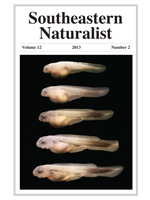Heterogeneity created through patchy disturbance is an important component of grassland conservation, but little research has focused on patch burn-grazing in grassland of the eastern United States. To test the viability of patch burn-grazing in a Tall Fescue-invaded old-field grassland on the Cumberland Plateau, we conducted a prescribed patch burn, stocked cattle, and measured vegetation structure and plant functional group composition. We found that patch burn-grazing creates spatial heterogeneity (patch contrast) for grass height, litter cover, bare ground, and canopy cover of native and exotic grasses. These results suggest that patch burn-grazing is a viable tool for heterogeneity-based grassland management in the region.
How to translate text using browser tools
1 September 2013
Preliminary Evidence that Patch Burn-Grazing Creates Spatially Heterogeneous Habitat Structure in Old-Field Grassland
Devan Allen McGranahan,
Gina M. Raicovich,
W. Nathan Wilson,
C. Kenneth Smith
ACCESS THE FULL ARTICLE

Southeastern Naturalist
Vol. 12 • No. 3
September 2013
Vol. 12 • No. 3
September 2013




